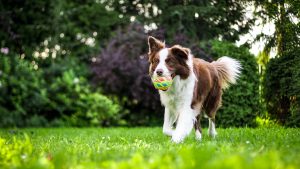
Just because your dog has gotten gray in the muzzle doesn’t mean your pup is ready to retire from being active. Old dogs need exercise, too. In fact, it might be even more important to exercise your senior dog to get the most out of his golden years.
“Exercise for senior dogs is important to actively keep their joints moving and keep their muscle mass and tone, because they start to lose muscle mass and tone with age,” says Desi Kelleher, DVM, a veterinarian in Westminster, MD. “But it’s important for their mental happiness as well. Dogs like to be active and need to move.” Plus, Dr. Kelleher says, spending time exercising your senior dog is also quality time: You’re bonding with your pup and helping him stay in tune with his environment, which makes his life more fulfilling.
You likely don’t need to be told if you have an older dog—you can see them slow down and have noticed a bit more silver in their fur, but the official definition of a senior dog according to the American Animal Hospital Association, is dogs in the last 25 percent of their life expectancy by their size and breed. Dr. Kelleher says for most dogs this is typically about 7 years old but can be as young as 5 for larger breeds like Great Danes and Pyrenees.
No matter the breed, your senior dog’s exercise routine can help manage his weight to reduce the risk of obesity and diabetes. Exercising your senior dog can also help with cardiovascular health, Dr. Keleher says. According to the American Veterinary Medical Association, most dogs are diagnosed with diabetes between the ages of 7 to 10, so keeping them active in their senior years is key. In fact, maintaining your senior dog's weight is one of the best ways you can help an older dog.
Exercise can also be helpful for keeping a dog with arthritis mobile. The more you move his joints, the more you’ll be able to maintain mobility. “A body in motion tends to stay in motion—just like with people,” says Sylvalyn Simpson, DVM, a veterinarian in Austin, TX.
It’s best to consult your vet to find out which activities are safest for your senior dog’s exercise routine—but these ten ideas can help keep your older dog feeling like a young pup.
1) Go for a walk
Yes, it sounds so simple, but it means so much for an older dog. The American Veterinary Medical Association praises walking as a way to preserve muscle tone and joint movement. “One of the best things you can do is an old-fashioned walk. It’s safe and there’s not much risk of heat exhaustion,” Dr. Simpson says. It’s a low-impact activity and you can go at a slow pace.
The key is to make sure you’re not overexerting your dog. “Let the dogs set their own limits—don’t push them too hard, especially in hot weather,” Dr. Simpson suggests. Start with a leisurely 15-minute stroll and adjust from there. You can add hills or more challenging terrain if your pup is up for it. Otherwise a simple stroll around the block can be enough to help improve his health.
2) Take a stand
Dogs tend to lose strength in their rear legs as they age so a good exercise for older dogs is “building up the rear.” The American Kennel Club recommends this move that helps to shift dogs' weight from the forelimbs to the back:
Walk your dog into a standing position with their front feet on a sturdy elevated platform like a step, exercise bench, or non-slip step stool. They should be looking slightly up at you with their shoulders directly over their 'wrists.' Stand in front of them and slowly feed them kibble for about ten seconds. Work up to 30 seconds.
3) Try the treadmill
If you have a treadmill in your house, it works just as well on four legs as it does on two! You’ll have to get your pup comfortable with the sound of the treadmill first. Take your time and give him treats for just standing on it while it’s powered off. Never tie your dog to it with the leash. Lure him with treats to get him walking with the treadmill on the lowest setting and once he’s adjusted you can increase the speed if necessary.
4) Go swimming 
"Swimming is a great full-body workout that won’t stress the joints or risk overheating," Dr. Simpson says. While some dogs intuitively take to the water, others sink like a stone, so it’s best to suit your pup up with a life jacket. Doggie paddling in a calm lake, stream, or pool is ideal. But you must be by his side at all times. You can also look into any rehab facilities that have hydrotherapy options for exercising senior dogs.
5) Find a physical therapist
You can get an exercise plan for your senior dog through a physical therapist trained to work with older dogs. A rehab veterinarian can combine various methods of pain control along with techniques to improve mobility including massage, stretching, acupuncture and hydrotherapy. Pet physio's can even create an exercise regimen for your pup in his golden years. Visit the American Association of Rehabilitation Veterinarians to find an expert near you and get guidance on the best exercises for older dogs.
6) Play hide-and-seek
"Any activities that cue foraging skills (like hide-and-seek) are good for a dog’s mental engagement," Dr. Kelleher explains. She suggests food puzzle games, Kongs that require a dog's attention to retrieve a reward, or simply hiding things they have to find around the house as a way to keep your golden boy mentally stimulated.
7) Stay low
“You have to be careful with jumping up and down as dogs get older,” Dr. Simpson says. So while playing Frisbee and fetch are excellent forms of exercise for older dogs, be careful of any issues with arthritis, hip dysplasia, or knee injuries. The safest way to play is to toss toys so your pup doesn’t have to jump to get them. He can still run and retrieve, and reap all the benefits of play without stressing his joints.
8) Have a tug of war
Another simple game that can benefit a senior dog is playing tug of war. It’s a full-body exercise that also engages the mind and helps your dog bond with you. You’ll have to pay attention to his level of play to make sure you’re not overexerting him, but it’s a great way to get your senior pup up and moving.
9) Ask about supplements
Since arthritis can slow an older dog down, Dr. Kelleher says you may want to speak to your vet about a joint supplement or an Omega fatty acid. She likes chondroitin sulfate, glucosamine, and GSM to help keep older dogs moving. Taking a joint supplement can help prevent or alleviate some joint conditions like arthritis that may inhibit your dog from being active.
10) Remember less is more
Your older dog likely isn’t up for a marathon workout session. “Frequent amounts of small exercise are best,” Dr. Simpson says. “Playing fetch more frequently rather than one long walk is a better plan, but the amount of time that’s comfortable is unique to each dog.” Shorter exercise sessions are safer for your dog and will ensure you both get the most out of your workout together.
~~~
Leave a note in the comments and let us know what your favorite game is to play with your senior pup! What's you favorite way to get him or her moving?


info@seniorpups.com
Copyright 2023 – All Rights Reserved by Senior Pups